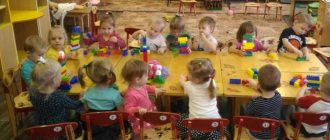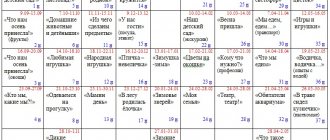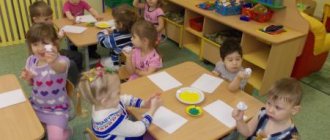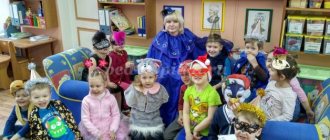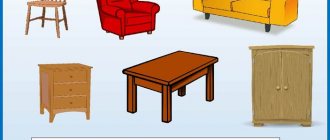Daily planning for junior group 1 on the topic My Home
| D/n | Time | WITH My house from 01.11 to 15.11 joint activity of an adult with children (group, subgroup, individual) |
| 1 | 2 | 4 |
| 01.11.16 VT | Morning |
Individual work AWARENESS WITH YOUR ENVIRONMENT goal: to expand children’s understanding of vegetables (carrots) |
| GCD |
DRAWING “Grass” Purpose : continue to introduce techniques for working with paints, learn to draw short lines, lightly touching the paper with a brush
PHYSICAL EDUCATION (in a group) Lesson No. 1 Goal : develop a sense of balance, improve running in a certain direction, the ability to respond to signals, | |
| Evening |
| |
| D/n | Time | Joint activities between adults and children (group, subgroup, individual) |
| 1 | 2 | 4 |
| 02.11.16 SR | Morning |
Individual work DRAWING goal: learn to draw short lines, lightly touching the paper with a brush |
| GCD |
SPEECH DEVELOPMENT Lesson No. 1 D/i “Who came?
PHYSICAL EDUCATION (in a group) Lesson No. 2 Purpose: teach children to walk on a limited surface, crawl and roll a ball, practice walking while maintaining balance. | |
| Evening |
|
Time
Joint activities between adults and children (group, subgroup, individual)
1
2
4
03.11.16
Thu
Morning
- Conversation with children on the topic “Dangerous objects at home” Purpose:
familiarize children with dangerous electrical appliances that are in the house
- Didactic game on ecology “Guess my riddle” Purpose:
learn to solve riddles based on keywords
- Outdoor game
“Who’s next”
Goal:
develop the ability to throw bags into the distance - FKGN
“We wash our hands before eating”
Goal:
to teach children to wash their hands before eating - Preliminary work on Modeling. - look at pictures of an airplane
Individual work on SPEECH DEVELOPMENT goal: to teach children to distinguish and name birds
GCD
- Artistic and aesthetic development
MOLDING “Airplane” Purpose :
consolidate the ability to roll out plasticine lengthwise and make an airplane out of sticks.
- Physical development
PHYSICAL EDUCATION Lesson No. 3
Goal :
teach children to jump forward on two legs, learn to throw a ball at a horizontal target,
S.Ya. Laise “Physical school for kids” p. 78
Evening
- Gymnastics after a nap,
- Role-playing game “At the doctor’s” Purpose:
fix the names of medical instruments
- Reading
Nishcheva “Like we have a big family”
Goal:
to form pride and love for the family - Didactic game for speech development “Find out by description” Purpose:
improve children's knowledge about family
- Independent activity of children
in the art corner goal:
to attract children to modeling from plasticine
Time
Joint activities between adults and children (group, subgroup, individual)
1
2
4
04.11.16
PT
Morning
- Conversation with children on the topic “What are useful vitamins?” Purpose:
give children an idea of what healthy fruits are
- Didactic game for speech development “Who lives where” Purpose:
teach children to distinguish between place of residence: house or apartment
- P/game “Stamped with feet” Purpose:
develop dance moves
- Outdoor game
“Horse-Fire”
Purpose:
to teach how to move by jumping - preliminary work on speech development. —
solving various kinds of riddles
GCD
- Artistic and aesthetic development
MUSIC (organized by music director)
- Cognitive development
SPEECH DEVELOPMENT Lesson No. 2 kindergarten “Veterok” Reading poetry by A. Barto “Who screams how” Purpose:
teach children to slowly exhale air through their mouth, introduce them to a riddle poem, improve their speech hearing.
V.V. Gerbova “Speech development in kindergarten children 2-3 years old”, 2015 (p. 47)
Evening
- Gymnastics after a nap
- KGN
— game situation “Who has the cleanest hands?”
goal:
to make children understand that their health depends on the cleanliness of their hands - Role-playing game “Choose dishes for dolls” Goal: consolidate knowledge of different types of dishes, develop the ability to use dishes for their intended purpose, cultivate resourcefulness, attention, speech
- M.P/ game “Stamped with feet” Purpose:
develop dance moves
- Independent activity of children
in the physical corner goal:
to encourage children to play with balls
Individual work in physical education. - teach children to jump forward on two legs
Time
Joint activities between adults and children (group, subgroup, individual)
1
2
4
07.11.16
Mon
Morning
- Conversation with children on the topic “What’s in our apartment” Purpose:
introduce children to furniture
- Work assignments together with the teacher
“Let’s water the flowers”
goal
: to teach how to care for plants - Outdoor game
“Along the Bridge”
Purpose:
to practice balance - Didactic game “Who works where?” Target:
clarify children’s knowledge about places of work - teachers, doctors, (their parents)
- preliminary work according to the environment. - consider a cube, ball, brick
GCD
- Artistic and aesthetic development
MUSICAL ACTIVITY
(organized by music director)
- Cognitive development
ABOUT THE ENVIRONMENTAL FEMP - Lesson No. 1 “What's in the bag? Goal: developing the ability to distinguish objects by shape and name them: cube, ball, brick I.A. Pomoraeva, V.A. Pozina “FEMP with children 2-3 years old, 2015 (p. 14)
Evening
- Gymnastics after a nap
Goal
: improving health - Role-playing game “Family” Purpose:
develop dialogic speech, distribution of roles
- Outdoor game
“Along the Bridge”
Purpose:
to practice balance - Didactic game on fine arts “Colors around us” Purpose:
practice finding a given color or shade
- Independent activities of children
in the book corner the goal is to arouse interest in books.
Individual work MUSIC - learn to walk one after another in a circle
Time
Joint activities between adults and children (group, subgroup, individual)
1
2
4
08.11.16
VT
Morning
- Conversation with children on the topic “What you can and cannot play with in the house” Purpose: p
familiarize children with what can happen if they play with furniture
- Designing buildings, playing out “My House” Goal:
learn to use the simplest scheme for construction
- P/i “On the path”
Purpose
: To develop coordination, teach to move along a given path, wait for your turn - FKGN “Table Behavior” goal:
Goal: to teach children to eat carefully, to hold a spoon correctly, to teach them to say “thank you” at the end of a meal (as adults remind them).
- preliminary drawing work - let older children see the finished works
GCD
- Artistic and aesthetic development
DRAWING “Leaf fall, leaf fall. yellow leaves are flying” Goal: to consolidate skills in working with paints. teach the technique of dipping, encourage to fill the entire surface of the sheet.
- Physical development
PHYSICAL EDUCATION (in a group) Lesson No. 2 Purpose:
teach children to walk on a limited surface, crawl and roll a ball, practice walking while maintaining balance.
S.Ya.Lize “Phys.kul.
for kids" p.77 Evening
- Gymnastics after a nap
- Didactic game for FEMP “Build a pyramid” Purpose:
development of fine motor skills
- Role-playing game “Treat” Purpose:
developing children’s ability to implement game plans
- M/Outdoor game
“Fast bugs”
Purpose:
to strengthen the ability to crawl on all fours - Independent activity of children
in the art corner -
to arouse children's interest in pencils
Individual work MUSIC
D/n
Time
Joint activities between adults and children (group, subgroup, individual)
1
2
4
09.11.16
SR
Morning
- Conversation on the painting “What is furniture made of” Purpose:
introduce children to furniture
- Outdoor game
“Horse-Fire”
Purpose:
to teach how to move by jumping - Role-playing game “Family” Purpose:
encourage children to creatively reproduce family life in play
- Labor assignment “Let’s bring order to the group”
Goal:
to cultivate a desire to work together - preliminary physical education work - prepare equipment
GCD
- Speech development
SPEECH DEVELOPMENT Lesson No. 3 nursery rhyme “The cat went to the market...” d/i “I came up with this” “goal: to consolidate the children’s ability to combine any toys with the action of 2-3, to introduce them to the folk song. V.V. Gerbova “speech development in kindergartens with children 2-3 years old” (p. 48)
- Physical development
PHYSICAL EDUCATION (in a group) Lesson No. 3
Goal :
teach children to jump forward on two legs, learn to throw a ball at a horizontal target,
S.Ya. Laise “Physical school for kids” p.78
Evening
- Gymnastics after sleep
- FKGN and self-care skills
: Game situation “Let’s comb and wash the doll.”
goal:
to instill neatness - Didactic game on FEMP “Seek and find” Purpose:
learn to find objects of different sizes in a room by word name
- M/Outdoor game
“Along the Bridge”
Purpose:
to practice balance - Independent activity of children
in the sports corner -
to arouse children's interest in playing with balls
Individual drawing work, teach the technique of dabbing, encourage filling the entire surface of the sheet
Time
Joint activities between adults and children (group, subgroup, individual)
1
2
4
10.11.16
Thu
Morning
- Conversation with children on the topic “What is furniture for?” Purpose:
introduce children to the purpose of furniture in everyday life
- Didactic game “Quiet - Loud” Purpose:
develop the ability to distinguish between quiet and loud sounds
- Low mobility game “Where is the bear hiding?” Goal: To develop attentiveness and visual memory.
- Exercise with massage balls Purpose:
development of fine motor skills, speech breathing
- preliminary work on modeling - consider the finished work of older children
GCD
- Artistic and aesthetic development
MODELING “According to plan” Purpose :
evoke a desire to sculpt from plasticine, create images of objects from rolled out columns of plasticine, and name them. beat
- Physical development
PHYSICAL EDUCATION Lesson No. 4
Goal :
teach children to walk on a gymnast.
bench, throw a ball from behind your head, practice crawling on all fours, S.Ya. Laise “Phys.kul.
for kids" p.79 Evening
- Gymnastics after sleep
- FKGN “Fluffy Towels” goal:
teach children how to use their towel correctly
- Role-playing game “Shop” Purpose:
teach children to take the game to its logical conclusion
- Outdoor game
“We stomp our feet”
Purpose:
to develop the ability to alternate walking and running in a circle in accordance with the text - Independent activities of children with
breathing simulators
-
arouse interest in the “rain” and “leaf fall” simulators
Individual work in physical education. - teach children to jump forward on two legs
Time
Joint activities between adults and children (group, subgroup, individual)
1
2
4
11.11.16
PT
Morning
- Conversation with children on the topic
“We speak with our hands and body”
Goal:
to give children an initial understanding of the culture of gestures, to develop creative imagination - Didactic game “Who is whose cub” Purpose:
introduce children to wild animals and their young
- Outdoor game
“Slide downhill”
Purpose:
to teach the game to act slowly, according to a signal - Pictures “Pets” Purpose:
expand children's understanding of pets
- preliminary drawing work - prepare the material
GCD
- Artistic and aesthetic development
MUSIC (organized by music director)
- Cognitive development
SPEECH DEVELOPMENT Lesson No. 4 D/I and exercises with cubes and bricks goal:
exercise children in distinguishing and naming colors, completing tasks to activate speech and hearing by V.V. Gerbova “speech development in kindergartens with children 2-3 years old” (p. 49)
Evening
- Gymnastics after sleep
- Outdoor game “On a difficult path.”
Goal
: develop coordination of arms and legs when moving, sense of balance, dexterity - Didactic art game “Magic Lines” Purpose:
develop graphic drawing skills
- Role-playing game “Hospital” Purpose:
distribution of roles, ability to use toys as substitutes
- Independent activity of children
P/I goal:
to encourage children to play in groups
Individual work in physical education. — teach children to walk on a gymnast. bench
D/n
Time
Joint activities between adults and children (group, subgroup, individual)
1
2
4
14.11.16
Mon
Morning
- Conversation with children on the topic
“The House We Live In”
goal:
to activate children’s speech, instill love for their home and
family members
- Outdoor game
“Find your color”
Purpose:
to train children in walking and running in all directions. To develop attention and reaction to the teacher’s signal. - Didactic game “Disassemble and assemble” Purpose:
teach children to assemble a whole from parts
- Labor instructions “Cleanliness and order” goal:
teach children to have order in the room
- preliminary work according to the environment. - look at objects of different sizes
GCD
- Artistic and aesthetic development
MUSICAL ACTIVITY
(organized by music director)
- Cognitive development
Familiarization with the surrounding FEMP Lesson No. 2 Collecting toys for a walk Goal: to develop the ability to distinguish objects of contrasting sizes and designate them with words: big, small I.A. Pomoraeva, V.A. Pozina “FEMP with children 2-3 years old, 2015 (page .15)
Evening
- Gymnastics after a nap
- Role-playing game “I am a driver” Purpose:
teach children to establish relationships in play
- Looking at the painting
“My family”
Goal:
expand vocabulary, enrich speech with adjectives - Outdoor game
“Who’s next”
Goal:
develop the ability to throw bags into the distance - Independent activities of children
with sounding toys goal: to arouse interest in musical instruments.
Individual work on speech development - to train children in distinguishing and naming colors
Time
Joint activities between adults and children (group, subgroup, individual)
1
2
3
15.11.16
VT
Morning
- Conversation with children on the topic
“Helping each other”
Goal:
to develop the ability to coordinate one’s actions with the actions of others To develop a desire to help each other - Outdoor game
“Find your color”
Goal:
To develop attention and reaction to the teacher’s signal - Didactic game for speech development “One-many” Purpose:
learn to form plural nouns
- FKGN “Cleanliness is the key to health” goal:
teach children to use soap and their own towel
- preliminary drawing work - examination of the finished works of older children
GCD
- Artistic and aesthetic development
DRAWING “According to plan” Goal: to consolidate the ability to use paints, recognize familiar objects in colored spots, play with them
- Physical development
PHYSICAL EDUCATION (in a group) Lesson No. 4
Goal :
teach children to walk on a gymnast.
bench, throw a ball from behind your head, practice crawling on all fours, S.Ya. Laise “Phys.kul.
for kids" p.79 Evening
- Gymnastics after sleep
complex - Role-playing game “Treat” Purpose:
develop children's ability to implement game plans
- Outdoor game
“Airplanes”
Purpose:
to teach children to act together - Didactic game based on r.r. “What kind of dishes?” Target:
learn to name dishes and describe them
- Independent activity of children
in the art corner -
to arouse children's interest in pencils
Individual drawing work - develop the ability to distinguish objects of contrasting sizes and denote them with words: big, small
</</p>
Project on moral and patriotic education of children in the first junior group “My family, my home”
Goal: to form a conscious understanding of the importance of loved ones in the life of a child and family.
Tasks:
- consolidate children's knowledge of the names of mothers, fathers, grandmothers, grandfathers;
- develop emotional responsiveness, a sense of pride in the family;
- cultivate love and respect for the dearest people on earth;
- encourage sensitivity to the emotional and physical state of loved ones;
- develop the gaming, cognitive, and speech abilities of children.
Relevance: It is necessary to cultivate patriotism from early childhood, not forgetting that everyone’s patriotism is formed individually. One of the leading factors in the formation of the patriotic consciousness of children is the cultivation of love for the child’s closest environment - family, home, kindergarten and their city.
Project participants : children of the first junior group, parents of students, group teachers.
Project type: short-term, group, creative.
Project duration: February 16 – May 16, 2015.
Project presentation:
- Exhibition of children's works.
- Photo newspaper “My mommy is the most…”.
- Newspaper for fathers and grandfathers “Glory to the Defenders of the Fatherland!”
Stages of work on the project:
- Stage I - preparatory (accumulation of knowledge).
- Stage II – joint activities of children, parents, and teachers.
- Stage III – final (result).
Thematic work plan
| Month | Content | Goals |
| February |
| Expand children's understanding of labor actions and the responsibilities of men. To give the idea that a man is a defender of the family, the Motherland. Introduce the types of Russian troops. To instill in boys a sense of duty, strength, responsibility, a desire to protect the weak, their homeland. Expand children's understanding of dogs, their service in the military, and their importance. |
| March |
| To give an idea of what kind of mother is - kind, gentle, keeper of the hearth. To cultivate respect for the female sex, to protect and protect mothers, sisters, and friends. |
| April |
| Expand children's understanding, replenish vocabulary and activate new and familiar words in children's speech. Cultivate love and responsiveness to your loved ones and parents. Give an idea of the work of adults and various professions; cultivate respect for working people. Give an idea of family responsibilities. Cultivate a love of work and a desire to help parents. Introduce the concepts of “street” and “address”. Help you remember your address. Cultivate love, respect for your street, a desire to improve it. |
| May |
| To instill in children a sense of respect for the elderly and old people. Give children an idea of military events and the significance of the holiday. |
Preliminary work:
- Consultation for parents to familiarize themselves with the topic, objectives of the project, and content of the work.
- Reading works of fiction about mom, dad, grandma, grandpa, family, holidays.
- Selection of illustrations and plot pictures on the topic of the project.
Selection of poems on the theme of the project: Z. Voskresenskaya “Mama”, “Mom’s Hands”, S. Mikhalkov “What do you have?”, N. Saxonskaya “Talking about Mom”, E. Blaginina “Let’s Sit in Silence”, M. Rodina “Mom’s Hands”, O. Chusovitina “My Grandma”, “The Best”, V. Rudenko “Men’s Holiday”, etc.
- Selection of photographs on the topic: “My mommy”, “Our family”.
- Learning poems, lullabies, nurseries, nursery rhymes
- Finger games “My family...”, “This little finger went into the forest...”
- Getting to know proverbs and sayings about family members.
The final stage:
- Exhibitions of children's works.
- Photo newspaper “My mommy is the best...”
Pedagogical project in the second junior group “My city: this street, this is my home”
Transcript
1 Pedagogical project in the second junior group “My city: this street, this is my home” Project passport Type of project: educational - informational, short-term, group. Duration: from year to year Project participants: children of the second junior group “Kids”, teacher, parents of pupils. Integration of educational areas: cognition, communication, physical education, safety, socialization, work, reading fiction, artistic creativity, music. Relevance of the project: Love for the Fatherland begins with love for one’s small Motherland and the place where a person was born. The goal of the project: to expand knowledge about your hometown and its attractions. Project objectives: 1. To form an idea of the Motherland based on familiarization with the immediate environment. 2. Introduce the basic rules of safe road traffic as a pedestrian and passenger. 3. To introduce children to the street, its features, freight and passenger transport. 4. Arouse cognitive interest, a desire to learn new things about your hometown. 5. Cultivate love for your hometown Borovichi, pride for your small Motherland. Work with parents: 1. Conversation on the topic “Patriotic education in the family.” 2. Joint productive activity of children and parents: “Houses and buildings.” 3. Exhibition of joint works “The House Where I Live”. 4. Conversation between parents and children about their city, home address, explanation of the rules of conduct on city streets and in public transport. Product of the project activity: 1. Panel “This is a street, next to it is a river” 2. Collective work on the art activity “Transport”. 3. Presentation of the project.
2 Expected result: 1. Increasing the level of children’s knowledge about their city, the street and its related concepts, as well as knowledge of transport, rules of behavior on city roads, in public transport. 2. Activating children’s interests in their small homeland and their city. Stages of the project: Preparatory stage: - selection of illustrations, paintings, recordings on the topic of the project; — selection of children's literature on the subject of the project; — selection of photographs of city views; — preparation of material for visual arts. Project content: - conduct cognitive cycle classes to familiarize yourself with the environment; — organize creative activities for children: Russian folk games, drawing, appliqué, modeling; - involve children and parents in the production of houses and buildings to decorate the street layout. Project implementation: Teacher activities 1. Replenishing the center of the book with photographs and illustrations of landscapes and attractions of our city. 2. Design of the photo album “My Favorite City”. 3. Develop a series of conversations and GCD on the topic of the project. 4. Making a card index for monitoring transport. 5. Design of an album of poems about the city of Borovichi. Children's activities 1. Reading fiction about transport, the city: poems, riddles. 2. Examination of illustrations “Passenger transport”, “Freight transport”, “Buildings”. 3. Artistic and productive activity: Drawing “House with a fence”, “Here is a car coming”, panel “This is a street, next to it is a river”. Application “Windows for the home”. Modeling “Bricks”, “Cars”. 4. Finger gymnastics. Parents' activities 1. Conducting conversations with children. 2. Help in replenishing the center of the book with illustrations and
3 photos. 3. Drawing “The house where I live.” 4. Making models of buildings and houses from waste material. 5. Walk with children around the city, pay attention to the beauty of the city landscape and the architecture of the buildings. Plan of work with children: 1 week Conversations: “What kinds of cars are there”; "We're going on the bus"; invitation to the driver's dad's group (story about the work of a truck driver). Examination of illustrations from the “Transport” series (freight, passenger); viewing a map of the city (note that all the streets of the city, the Msta River, which divides the city into two parts, are marked on the map); Observations: targeted walk to the truck, observation of the bus (where it stops, rules of behavior in public transport), Reading fiction: B. Zakhoder “Builders”, “Chauffeur”; S. Mikhalkov “A car was walking down the street”; V. Berestov “This is me going running” Artistically productive activity: designing “Garage and gates for transport”, drawing “House with a fence”, sculpting “Car”, applique “Bus for children”. Physical education Finger gymnastics “I walked alone”, “Home”. Role-playing games: “Gas Station”, “Car Repair”. D/games: “Buy the right part for the car”, “Say it correctly”, “Fix the car”, “Transport” (orientation in color, shape of objects, classification of objects), “Stand where I say.” Singing: “The car, the car is moving, it’s buzzing.” Week 2 Conversations: “What kind of houses are there” (examination of a multi-storey building: entrance, stairs, mailboxes, doors; and a private house: fence, yard, porch, garden; pay attention to the differences), “City streets”, “Purpose of a traffic light with using a poster"; “The house where I live” (name of the city, street). Examination of photographs “Sights of the city of Borovichi (Belelyubsky arched bridge” across the Msta River; railway station where trains arrive); looking at the poster “On Our Street”.
4 Observations: target walk “We get to know the street”; monitoring traffic on the roads, reading fiction: N. Kalinina “How the guys crossed the street”; S. Mikhalkov “My Street”; S. Marshak “For pedestrians.” Artistically productive activities: building high and low houses, drawing, sculpting “Bricks”, applique “Traffic Light”, laying out city streets from blanks, painting silhouettes of houses and other city buildings, creating the panel “This is our street”. Physical education Finger gymnastics “Man on a walk”, “Our walk”. Role-playing games: “We are traveling on a bus”, “Chauffeurs”. D/games: “The third wheel”, “Where to put what?”, “Assemble a traffic light”, “Right - wrong”, “Make a whole”, “Is it possible or not.” Activities: 1. Excursion “Streets of our city” 2. Exhibition of joint works of children and parents “The House in which I Live”. 3. Design of a street model (joint work of the teacher and children to make a model of the roadway, sidewalk and traffic light; children and parents to make models of houses and buildings from waste material) As a result of the project: Children will increase their level of knowledge about their city and its objects and attractions, about the variety of types of transport and means of transport. There will be an interest in your small homeland and your city. Knowledge about the street and its features, knowledge of the rules of behavior on city roads and in public transport will be formed. Conclusion Love for the Fatherland begins with love for one’s small homeland and the place where a person was born. Thus, it is possible to develop love for the Motherland, for one’s hometown, for one’s native nature only at a young age. Summary of educational activities for children 3-4 years old on the topic: “On the streets of the city” Program content: to give children an idea of the street and its features, the purpose of a pedestrian crossing, a traffic light; develop interest in various types of games, the ability to observe and draw simple conclusions; develop the ability to lead correctly
5 yourself on the street; promote the inculcation of a culture of safe behavior on the road through game images. Integration of educational areas: cognition, socialization, communication, physical education, health, safety, reading fiction. Materials and equipment: model of a roadway with a pedestrian crossing (“zebra”), strips of brown paper (sidewalks), models of houses and buildings, model of a traffic light, steering wheel. Previous work: reading fiction by S. Mikhalkov “My Street”, S. Volkov “About the rules of the road: pedestrians and cars”; examination of illustrations and photographs “Streets of our city”, targeted walks along the nearest streets (examination of traffic lights), d/game “Our friend the traffic light”, buildings made from building material “This is a street” NOD progress: Educator: “Children, we live with you in the city of Borovichi. There are many streets, different houses and buildings in our city. There are a lot of cars rushing along the roads at high speed, and pedestrians are crossing the road.” What cars did you see on the road? That's right, trucks (they transport goods), cars, buses (they transport people). - What do they call the people who travel on the bus? (passengers). And in passenger transport you have to buy a ticket, go through and sit in an empty seat, and follow the rules of behavior. Transport helps us quickly get where we need to go. There is a knock on the door, the teacher brings in a boy's doll. - This is Toropyzhka. They call him that because he is always in a hurry. He was in a hurry to visit us, but on the way he got into an unpleasant situation. - Hello Toropyzhka, what happened to you? “I wanted to bring gifts to the guys, but there are so many of them that I don’t know how to deliver them.” - Let's, guys, tell Toropyzhka how you can bring all the gifts at once. (by truck). Toropyzhka: — What kind of cargo can trucks transport? (Furniture, bricks, boards, sand, food). — Who drives passenger and freight transport? (Drivers). — Cars are our assistants, but without a driver they cannot work. — Let’s play the game “Transport the cargo.” (Children, at a signal, turn into any truck and move around the group, without colliding, carefully transporting their cargo. After the game, the children tell what color trucks they were and what cargo they transported). Toropyzhka: - And now I know how to bring gifts. I'll load them into the truck.
6 - Toropyzhka, do you remember how to get to us? After all, there are a lot of streets in the city and they have different names: there is Pushkinskaya, Gogol, Podbelsky (Toropyzhka shrugs). Our kindergarten is located on Botanicheskaya Street. Toropyzhka: “You all say a street, but what is a street?” - Let's tell you guys and show you what a street is. And you, Toropyzhka, look and remember. — This is a road, it’s called a roadway (children put a model of the road on the floor), cars drive along it towards each other, and this is a sidewalk (they lay out paths along the road) people walk along it. Tell me, what do you call people walking down the street? (Pedestrians). They walk along the sidewalk at a calm pace, sticking to the right side so as not to disturb each other. All that remains is to arrange the houses and buildings (children arrange models of houses and small cars). This is how our street turned out. Toropyzhka: - Hurray, I can cross the street. (Toropyzhka runs across the road). “Toropyzhka, you can’t cross the road like that, you might get hit by a car.” Now the children will tell you and show you how to cross the road correctly. And you can only cross the road in a special place. Reading an excerpt from S. Volkov’s poem “About the rules of the road. How to cross the road." Here is the usual transition. Everyone, go to your store. People walk along it. He sees that the street intersects with the road, There is a special marking here, And this intersection is aptly called a “Zebra”! It's called a crossroads! White stripes here So that near the intersection They lead across the street! You crossed the road, Pedestrian crossing sign, All colors at the traffic light Where is the pedestrian on the zebra crossing, You need to remember well! You find a red light on the street - and cross under it! No way for pedestrians! Approach the zebra crossing and wait, Yellow means wait, Don’t rush forward: But the green light, go! Look to the left, if there are no cars, go. You look to the right, there are no cars. While reading the poem, children perform actions in accordance with the text. - Now do you understand, Toropyzhka, how to cross the road correctly? (Yes, thanks guys)
7 — Our friend traffic light came to visit us. Let's show Toropyzhka what kind of fires he lights. D/game “Our friend the traffic light” (The traffic light is not working, we need to fix it; repeat what each color means). Toropyzhka: - Thank you guys, you taught me a lot, I will be very attentive on the street, but it’s time for me to get gifts. I'll bring them by truck. Goodbye. - Goodbye Toropyzhka, come and visit us.
